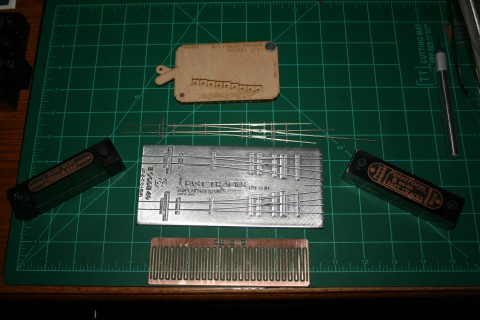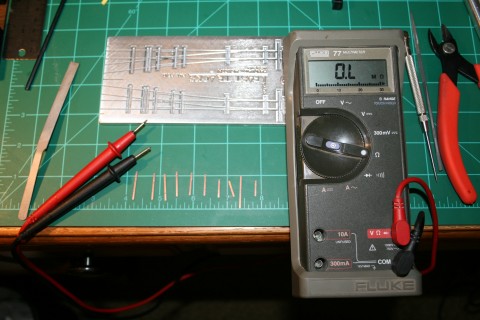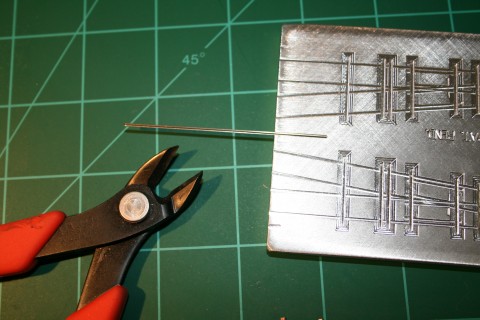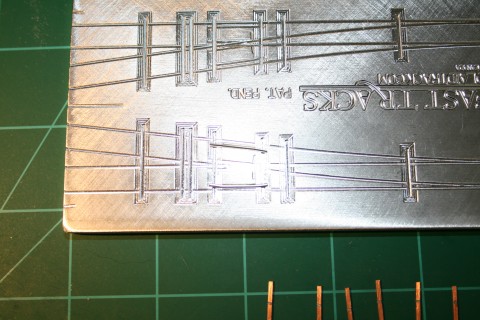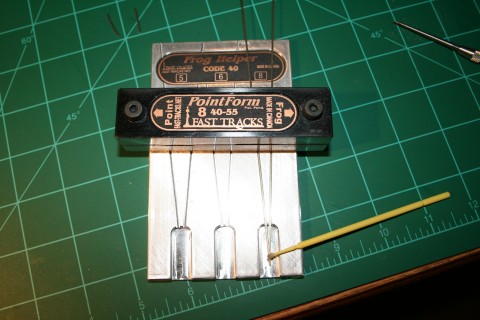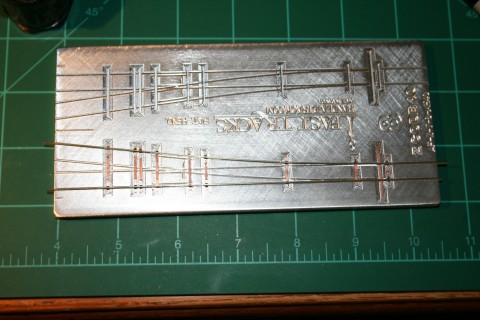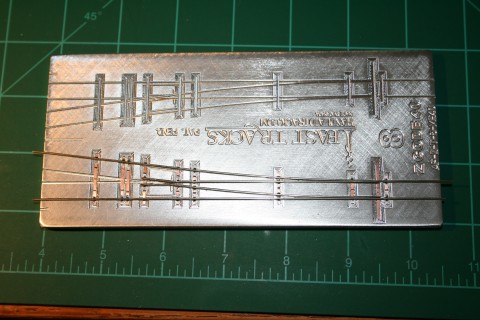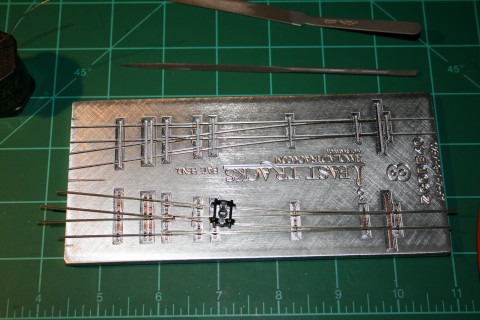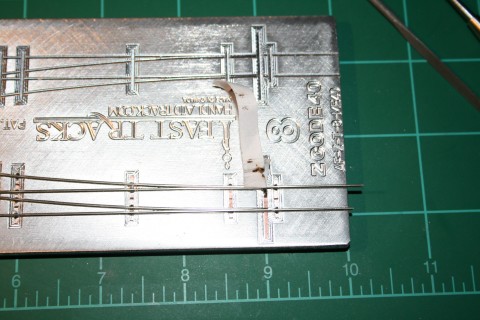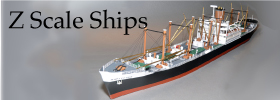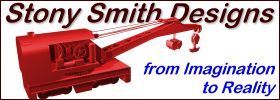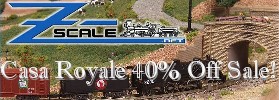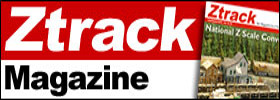Hand-Laid Turnouts the Easy Way
I’m not afraid of hard work. Never have been. But if I can work smarter, I’d rather do that. In this case, it’s long been a…dream, I suppose, to learn to build hand-laid turnouts. It always seemed like something only twelfth-level Jedi track masters could do.
But then I discovered Fast Tracks. In my last post I talked about using their tools, and at the risk of sounding like some sort of groupie, I’m going to talk about them again. Why? Well, for many reasons I suppose. First, it’s actually quite enjoyable if you like building models versus buying pre-built things. The tools work, and work well. The resulting track is fantastic, both in appearance and in operation. And they’re a small business trying to make it in today’s economy, so if I can help, I will. I’ve helped with my pocketbook, and now I’m helping by showing you it’s not hard at all to build your own track.
Being an engineer (computer, not railroad), I can respect what Tim Warris, the founder of Fast Tracks, has done. He’s a tool and die guy, so his work involves computer-aided design (CAD) along with taking those designs to machines that drill, grind, hone, route, and smooth metal or wood to implement his design. But he’s also a modeler who hand-lays track. He decided to build a fascinating layout, the concept for which is even more amazing since it’s real, or was.
I’m talking about the Central New Jersey Bronx Terminal. Now, if you’ve never heard of this particular line, you’re probably in good company. I certainly hadn’t. But a century ago, in the Bronx, New York, there was a 1x1 city block dedicated to freight cars that would arrive by barge. It had no other outside rail access. Inside this city block was a unique freight warehouse, with some of the most bizarre track I’ve even seen (see http://www.bronx-terminal.com/wp-content/uploads/1-Bronx2L.jpg). This was how citizens in the Bronx got fresh fruit, meat, and other consumer goods, or certainly at least one way.
From a modeling perspective, the problem is pretty apparent when you look at track like you see in Tim’s blog (the image link above). Now, I’ve never met Tim, but I suspect he’s a twelfth-level Jedi track master, and this level of complexity appealed to him. It is fascinating, to be sure, and I’d love nothing more than to buy him a beer to talk and learn more. How to actually build something like this?
Well, long story short, Tim combined his machining skills with his track skills and created “fixtures” for the various pieces of layout. One thing lead to another, and now he has an entire line of tools that you can use to create trackwork yourself. And since his tools are precision-machined, your trackwork comes out precise and repeatable. You get a winner every time, at least once you learn some basic skills, like soldering. I should also note these turnouts work with DC or DCC.
If you find this interesting at all, by all means visit his site at http://www.handlaidtrack.com/. He has online videos where he shows you, in detail, how the tools are used. He also describes how a turnout actually works and what dimensions are critical for good operation. This site is a treasure trove of information you will find difficult to locate elsewhere. If you want to build track, this is the place to go.
In any case, what’s the goal of this post? Why, to use the tools to build a Z scale #8 turnout. I need a small handful for the layout I’m building. I’ll also need several #6’s and curved turnouts and crossovers like I built in the previous post. The suite of tools I’ll use is shown here.
(Apologies for the poor photography…) What you see is the Z scale #8 fixture in the center, milled from high-grade aircraft aluminum. To its right is a PointForm tool, which is used to create the frog and points. To the left is a StockAid tool that helps with notching the stock rail. The copper fingers you see are printed circuit board ties (“PC ties”). We’ll cut these using the TieBreaker tool above the fixture. Actually, I would use the TieBreaker but this particular one is for the #6 turnouts. I’m waiting for my #8 TieBreaker to arrive in the mail. So I’ll cut the ties the old-fashioned way, which is to lay them into the fixture, mark the length, and cut/file to fit. But I’d use the TieBreaker if I had it! The turnout you see just above the fixture is what we’re going to produce. It’s typically referred to as a “skeleton.” The skeleton is glued to precision, laser-cut ties called QuickSticks. In short, the entire process is well thought out, and Fast Tracks provides tooling for each step.
Let’s begin.
In this image it’s a bit hard to see, as the shiny aluminum glares back at the camera.
But I’ve cut some of the ties from the stringer (Tim refers to them as “frets” of ties), and I’m laying them into the slots for the right-hand turnout. I’m marking the length with the scribe, then cutting with the rail cutters and filing with the files. The goal here is to place a tie in every depression, where each tie is neatly trimmed and the ends are squared up. It’s important the ties lay flat, since the rail will be soldered onto the copper cladding. If the ties sit up in the fixture improperly, the rail won’t sit properly either.
Of course, model locomotives operate using electrical current in the rails, so we have to be cognizant of shorts. Since the ties are completely clad in copper, we need to remove some of the copper so both rails don’t short out. In this image, although again somewhat hard to see (Z stuff is quite small, after all!), I’ve notched the copper cladding in the ties and verified there are no short circuits using my multi-meter.
While I have the ties out, I’m going to fabricate the two guard rails. These are more than eye candy. As it happens, the guard rails are critical to how turnouts operate, so they’re not something to overlook or take lightly. In this case, the fixture has notches you use to cut rail to the appropriate length and then bend the edges to the proper angles.
Here I’ve laid the guard rails into the fixture to be completely sure they fit correctly. In HO I’d use an NMRA gauge later in the build to verify correct flangeway distances, but in this case, for Z scale, I rely on the fixture. Because of this I make doubly sure the guard rails are going to sit correctly on the ties.
With the guard rails fabricated, I’ll next assemble the frog rail. For this step I slip a length of rail into the PointForm tool. In the image you see the rail jutting out the right side at an angle. The end you can’t see also juts out, and it’s this end I’m going to file to a very sharp point. The PointForm tool is precision milled to give us the correct angle. For a #8 turnout, that would be 8 parts over and one part up, so to speak, or in other words a right triangle with a base of 8 units and a height of 1. Doing some basic trigonometry we find the angle to be 7.18 degrees. I’m not joking when I say that filing a piece of rail to that angle is a masterful job without this tool!
With both sides of the frog filed, I need to solder them together. I can do this in the fixture, but I use the Frog Helper tool instead. This tool gives me a little more room to solder and doesn’t sink the heat. I get a clean joint every time. Here you see I’ve placed the PointForm tool on the filed rails to secure them and have applied solder flux to the frog itself. I’ll heat this with my soldering iron and apply solder.
Once the solder hardens, I can pull the rails from the Frog Helper and admire a razor-sharp frog. No wheel in the world will get caught up on this frog!
With the frog soldered, I’ll set it aside for the moment and turn to the stock rails. These flank the turnout: one goes straight and one diverges. The switch point location dictates which direction the train takes, but to make that happen we have to notch the stock rails a bit so the points can snuggle up. If we don’t, the wheels will certainly catch the point rail and derail the locomotive, or certainly some car in the consist will complain. This notch is also something we need to be very precise about creating, and using the StockAid tool does just that.
Here I’ll file down the rail flange, leaving me with a perfect stock rail every time. Modelers used to use belt sanders, or files and vices, and Tim claims for every three he filed he might get one good one. This tool makes short work of the process and you get a perfect rail every time.
So what to do with these stock rails? Once filed, they go into the fixture and are soldered to the PC ties. Here you see the turnout begin to form.
Next I need to create the point and wing rails. I’ll use the PointForm tool to file the ends of the rail to a sharp edge that fits into the notch in the stock rail. I’ll then bend the point rail to form the wing, as you see here.
These are soldered to certain ties, but not to all since they need to move.
With the wing rails in place I can solder in the guard rails.
I’ll be careful here to make sure the guard rail sits squarely on the tie. If the rail is canted either way, it throws the geometry off, so I take care. But once those are in, I can fit the frog rail I created earlier. I’ll slide the frog to the left or right to get the best fit, which I check using a set of trucks. Generally the optimum location is seated as deeply into the wing rails as possible, but I always check.
I’ll solder this rail onto the ties as well as between the end of the frog and the wing rails, so it’s secure and won’t ride up on the roadbed. We don’t want the frog sticking up, just waiting to trip up an unsuspecting GP38.
So now the basic rail geometry is in place, but we still need to deal with the switch points. So I lift the end of the skeleton from the fixture and slip a small piece of paper between the straight point rail and the throwbar tie. The paper keeps me from inadvertently soldering the point to the stock rail. I’ll put down a nice ball of solder to make this a nice strong joint.
I can’t solder the other point rail to the throwbar tie in the fixture, so now we gently remove the skeleton and solder the other point rail. The width of a tie is the perfect spacer. And with this joint the skeleton is complete.
Now, I wire-brush the skeleton to remove solder flux residue. I also like to wipe it with lacquer thinner, as I know I’m going to eventually paint it. Once cleaned, I’ll apply contact cement to the underside of the rails and set it aside to dry.
I then grab a QuickStick and apply contact cement to the rail guides. For Z turnouts, I’ve learned to skip this for the ties near the throwbar tie since the gooey glue can glob out and interfere with the point rail movement. Instead, for those ties I use CA glue. For larger scales this isn’t such a problem, since you have wider rail and more tie material to work with. But for Z I’ve learned the glue globs just muck up the works in this sensitive area.
Once the contact cement has dried on both the skeleton and QuickStick, I can press them together to form the completed turnout. Beautiful!
I’ll place this on my desktop and put heavy weights on top of the rail to apply pressure as the glue sets, typically overnight. Once hardened, I snap the stringers off the QuickStick and admire the nearly completed turnout.
I say “nearly completed” because we need to electrically isolate the frog. To do that I’ll place the turnout in a small vice, and using a jeweler’s saw, I’ll cut the rails before and after the frog. When I secure the turnout to the roadbed, I’ll bring a wire up from underneath to supply the frog with the appropriate polarity.
I now have a hand-crafted turnout that exceeds the performance of any store-bought unit, and it’s one I’ll be proud to glue onto my roadbed and ballast. (If you’re wondering, I’ll use SG-90 micro-servo motors to actuate the turnouts…a post for another time.)
Comments 5
these are a lot of work, you really have to put a lot of time into getting everything correct. On my small layout, I used a polarity swither to multi-turnouts. What I haven't found yet is a way to add an easy manual switch to the turnouts that look good other than the underneath complex manual switches or expensive turtoise switch machines....
Part of the beauty of the fixture is you get it right much more than wrong. And you can have one built in less than an hour, and have a lot of fun doing it. Well, at least I find it so. As for driving them, I use MegaPoints controllers with opto-couplers I get from eBay. See http://megapointscontrollers.com/megapoints/index.html for the controllers. They're the most expensive part. The opto-couplers are quite inexpensive. I then use the inexpensive servo's to drive the turnout. You can literally drive 30 turnouts for a few hundred $, which by itself sounds like a lot, but compare that to fabricated/manufactured track with built-in machines... It takes some experimenting and learning, but it's worth it. Thanks for reading...

